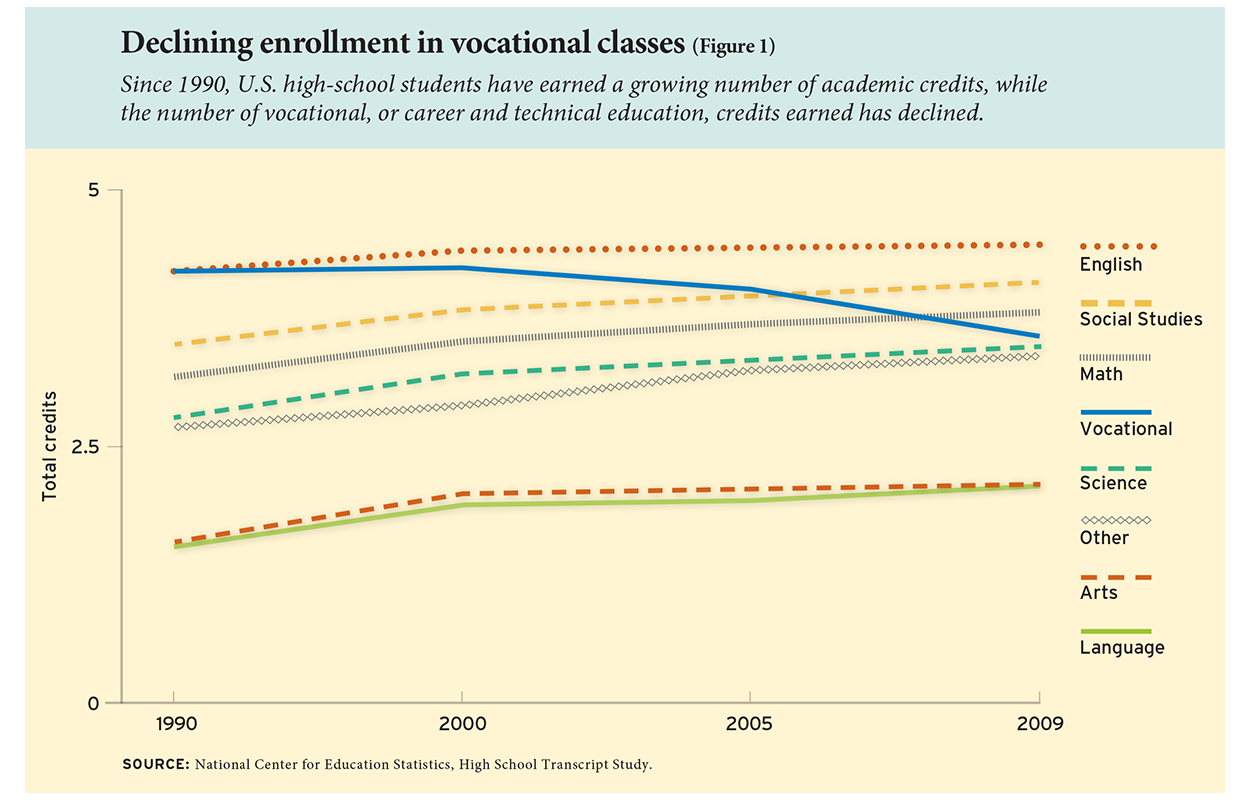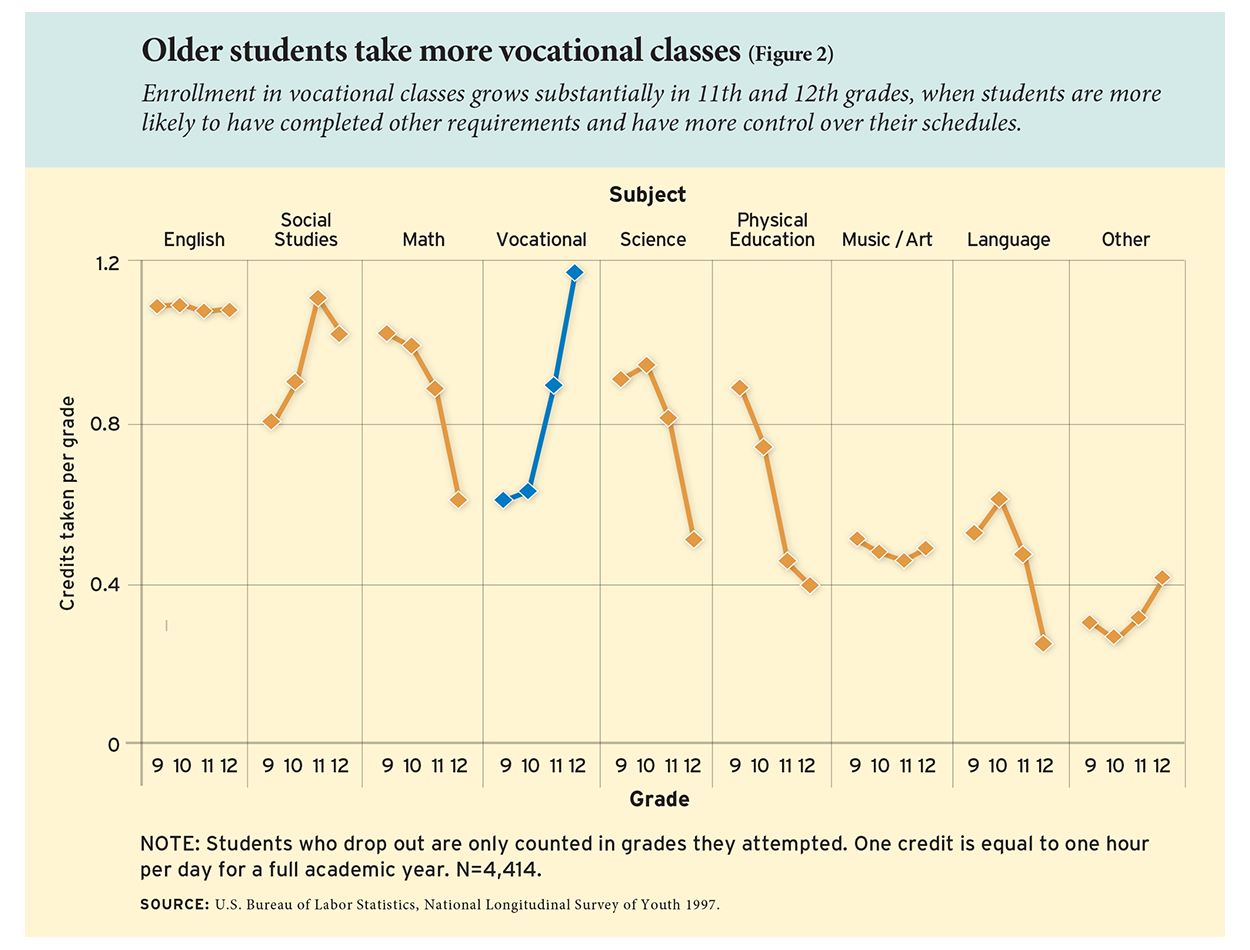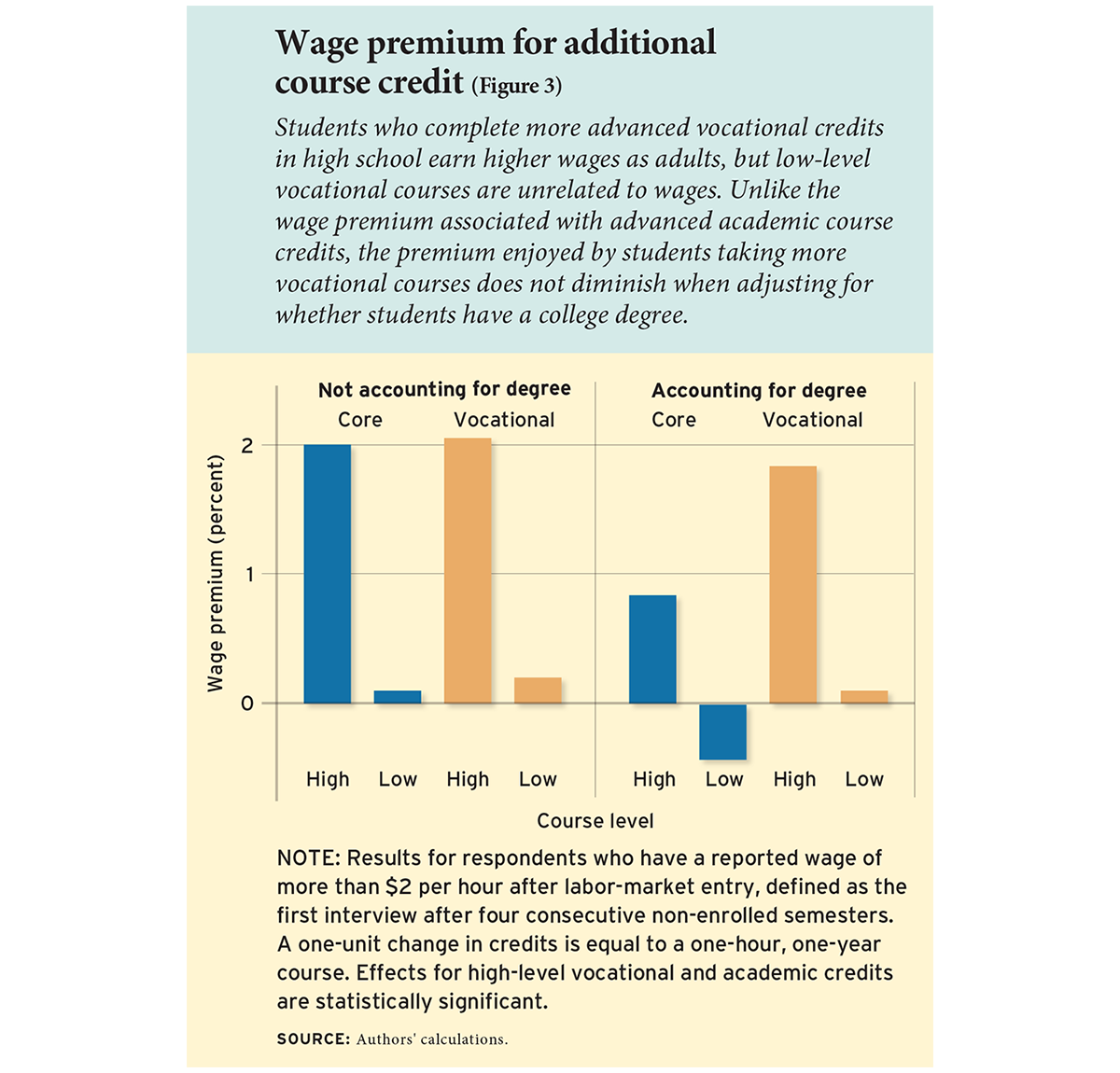Since the publication of A Nation at Risk in 1983, policymakers and politicians have worked to stave off a perceived decline in the academic preparation of American students. Stubbornly low scores on international exams and signs that many U.S. graduates are ill-equipped for college and the workforce have lent urgency to this perception, and many states have made high-school graduation requirements more rigorous in response. As a result, American high-school graduates today complete more academic courses and more advanced coursework than they did three decades ago. At first glance, this seems clear evidence of progress.
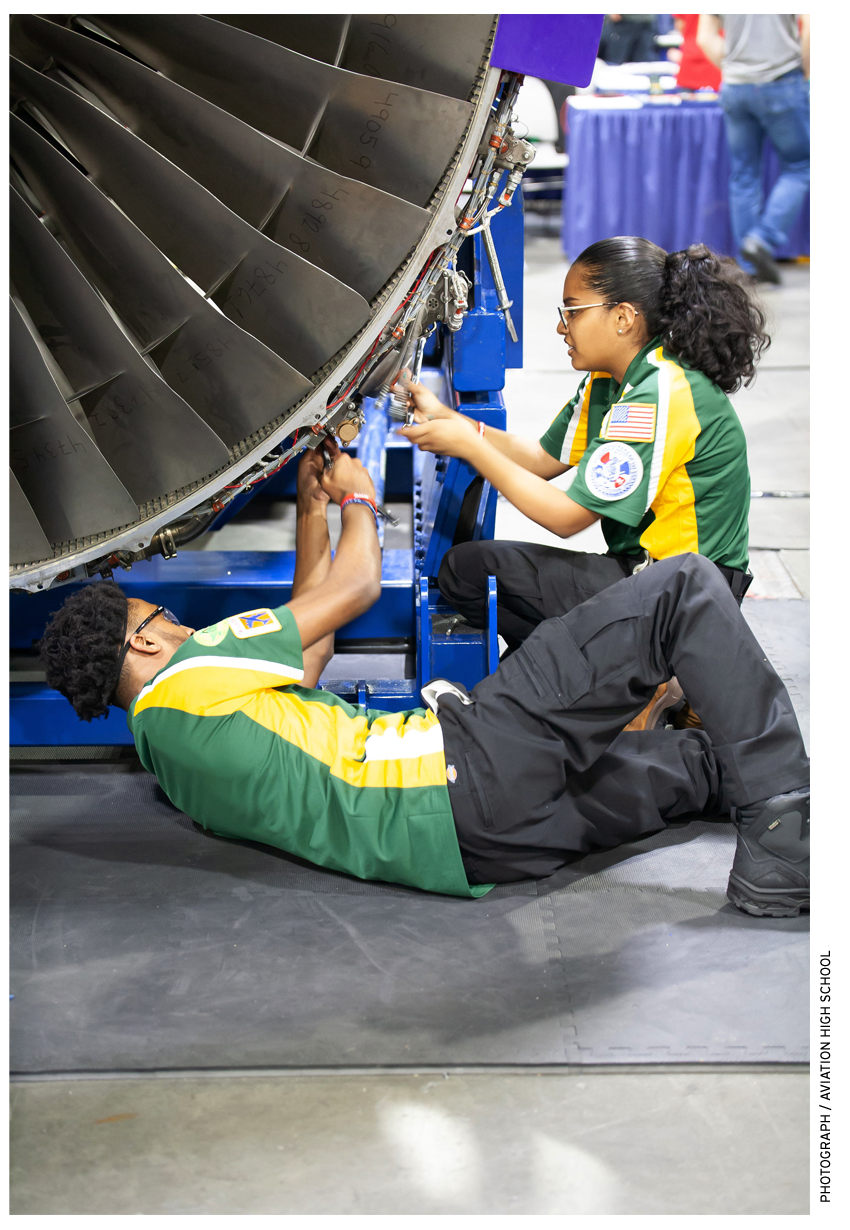
But much of those gains have come at the expense of student participation in vocational, or career and technical education, classes—a broad category of coursework that encompasses everything from welding, to sports management, to computer science. Many praise this shift, arguing that vocational education in high school deters capable students from college and prepares them for “dead-end” jobs. Yet an opposing camp points to shortages in the skilled professions, noting that not all students are college-bound and that for some, vocational training may be the difference between high- and low-paying jobs. Pushing all students to concentrate on core academic classes at the expense of vocational study, advocates say, takes the focus off the occupationally relevant skills and credentials graduates need for a smooth transition to adulthood.
This raises a central question: What is the relationship between modern-day vocational or career and technical coursework and high-school graduates’ success in college or in the workforce? Is vocational education an off ramp to college foisted upon lackluster students, or a different and less costly path toward adult success? We examined high-school and college transcripts and labor-market outcomes for about 4,000 adults to find out.
Our study, making use of a nationally representative sample of early-career Americans, shows that students tend to enroll in vocational classes based on whether such options are available to them, suggesting that the commonly held belief that marginal students are funneled into such classes is untrue. Further, we find that not all vocational classes are equal: students earn about 2 percent more annually for each advanced or upper-level vocational class they take, but enjoy no wage premium for having completed lower-level or introductory vocational study. In terms of college enrollment, while lower-level vocational courses may deter marginal students from college, they have no impact on net graduation rates; advanced courses at worst do no harm.
The implications are considerable. First, students most likely to benefit from vocational coursework seem to be self-selecting into those courses, implying that policies that limit their ability to do so, such as increased course requirements in academic subjects, may not be in all students’ best interests. Second, we find that vocational courses may pull students out of college who are the least likely to graduate if they enroll. Finally, the benefits of vocational coursework accrue to students who specialize rather than those who take multiple vocational courses in several areas; therefore, programs should allow for depth in any topic offered. Recent trends toward more specialized concentrations or “pathways” and away from general, non-specialized coursework appear to be smart policy.
A curriculum continuum
In recent decades, vocational study in high school has been on the decline, in tandem with a 32 percent drop since 1985 in federal funding for such programs. Between 1990 and 2009, as the average number of academic credits high-school students earned increased, the number of vocational credits dropped by 14 percent, or roughly two thirds of a year of vocational studies (see Figure 1).
However, the vast majority of American students still take at least one vocational course during high school, and roughly 50 percent take the equivalent of one full course each year. This contradicts the mainstream image of vocational study as an alternative “track” in which students do not complete a full complement of academic classes. We should instead think of the high-school curriculum as a continuum, in which the real question is just how many vocational classes students select. Our study takes this perspective.
To trace students’ choices to enroll in vocational courses and their effects, we examine schooling and labor-market activity for participants in the 1997 National Longitudinal Survey of Youth, collected by the U.S. Bureau of Labor Statistics. These data cover a nationally representative group of 8,984 individuals who were ages 12 to 18 when first interviewed, and include detailed information from the high-school transcripts of 6,009 of them. Importantly, the study collects detailed information on each individual, including scores on the Armed Forces Qualification Test, family background data, and annual records of college going and work histories.
In reviewing those records, we focus our attention on the 4,414 participants who have transcripts in all years of high school and relevant college-outcome records. When studying earnings, we use the 3,708 students whom we determined had completed schooling and entered the labor market. (We define labor-market entry as the first of four consecutive semesters an individual is not enrolled in any educational institution followed by no more than one enrolled semester thereafter.) The median age of our sample in the most recent round of data collection, which occurred in 2010, is 29.
In looking at high-school transcripts, we consider classes to be “vocational” if they focus on general or specific labor-market preparation under the Perkins Act according to the National Center for Education Statistics, excluding family and consumer sciences. The most common types of vocational courses taken are transportation and industry, business and management, computer technology and keyboarding, and general labor-market preparation classes such as industrial arts or work experience opportunities. Courses classified as “first course” in a sequence are considered low level, while courses listed as “second or later,” “specialty course,” or “co-op/work experience” are considered advanced or upper level. This distinction allows us to analyze the benefits of breadth (taking many courses in different fields) and of depth (specializing in a particular vocational field). We also conduct an analogous disaggregation for the core academic courses of English, math, science, and social studies, based on the transcript labels of “basic,” “regular,” “advanced and honors,” “specialized,” and Advanced Placement or International Baccalaureate.
Approximately 95 percent of the students in our sample took at least one vocational class. One third of the students in the sample obtained a four-year college degree, one third attended college without earning a degree, 8 percent earned a two-year degree, 19 percent obtained a high-school diploma but no postsecondary education, and 3 percent did not graduate from high school (recall that we limit our data to students with four years of high-school records, so we exclude most dropouts).
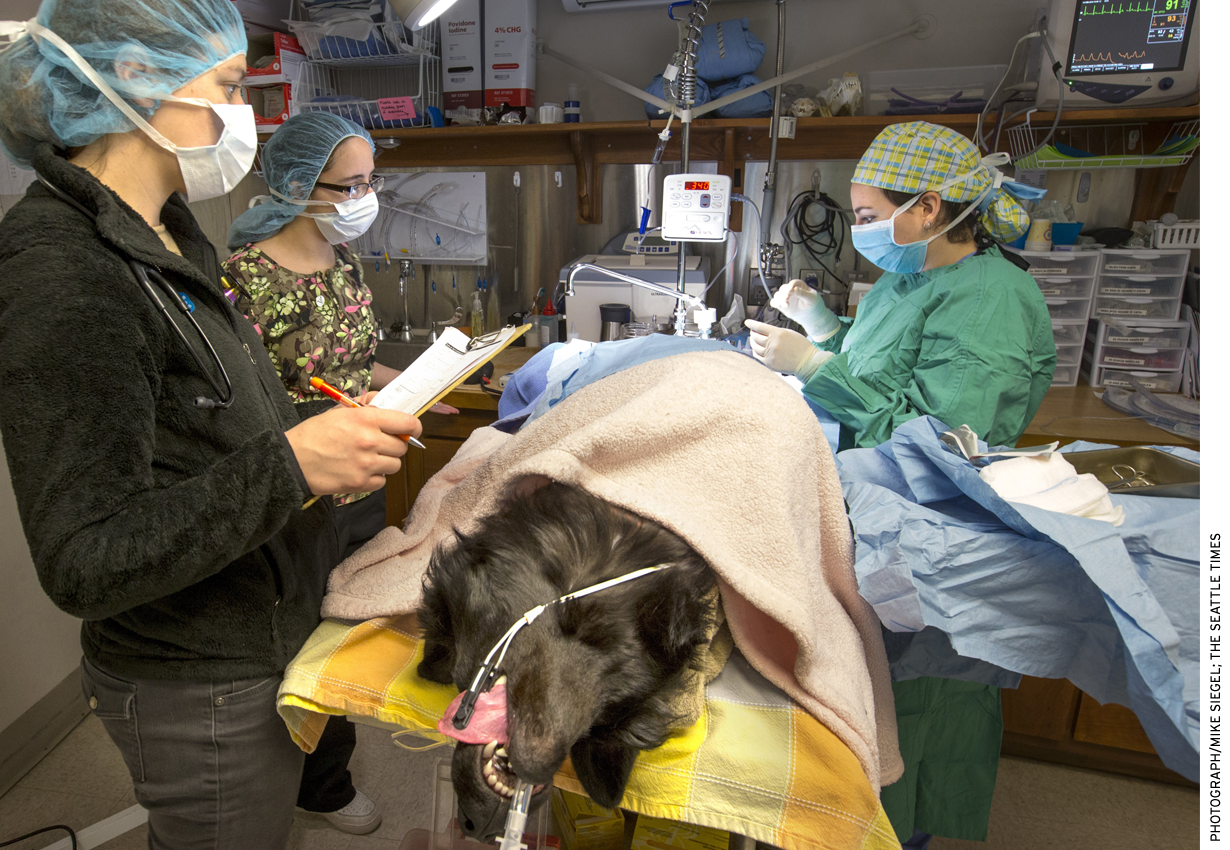
Who takes vocational courses?
To learn which student take the most vocational classes, we examine course-taking patterns by a variety of student characteristics, including year in school, gender, race, grade-point average in 9th grade, and parental education. Consistent with prior research, we find that males, students from disadvantaged backgrounds, and students in rural and southern states are more likely to take vocational classes. We also see notable relationships between course taking and ability as measured by the Armed Forces Qualification Test, which assesses reading and math skills. Students with high scores take about two thirds as many vocational courses but also take more science classes and about three times as many foreign-language courses as do students with lower scores.
On the whole, students enroll in vocational courses with much greater frequency in 11th and 12th grade as they approach graduation and ostensibly have more control over their schedules (see Figure 2). This highlights the tradeoff students face in high school between what are traditionally seen as “college prep” courses and learning workforce skills. Social studies classes exhibit a similar though weaker trend, while math and science course taking drops considerably in 12th grade. In other words, specialization in vocational coursework has a distinct temporal aspect, and students’ experiences early in high school may inform their later course choices.
This line of thinking suggests that information revealed to students during high school could influence their course selections over time: students’ grades in academic courses taken as freshmen, for example, could provide information about their perceived “fit” with academic vs. vocational curricula and thus influence their decisions. Economists have shown that students’ course performance early in college helps to explain their choice of major. Consistent with this logic, we find that students who performed poorly in math and English in the 9th grade are more likely to take vocational courses later in high school. A one-point increase in 9th-grade math and English grade-point average decreases total vocational course taking by 15 percent of a one-year course, a decrease of roughly 5 percent off the average of approximately three total vocational courses.
We also examine which students enrolled in only introductory courses, and which enrolled in advanced courses. We find that students with poor performance in math and English in 9th grade were more likely to enroll in introductory-level vocational courses in grades 10–12. Yet the same is not true for advanced vocational coursework. Students with weaker academic performance were no more likely than those with strong academic performance to enroll in more-advanced vocational courses.
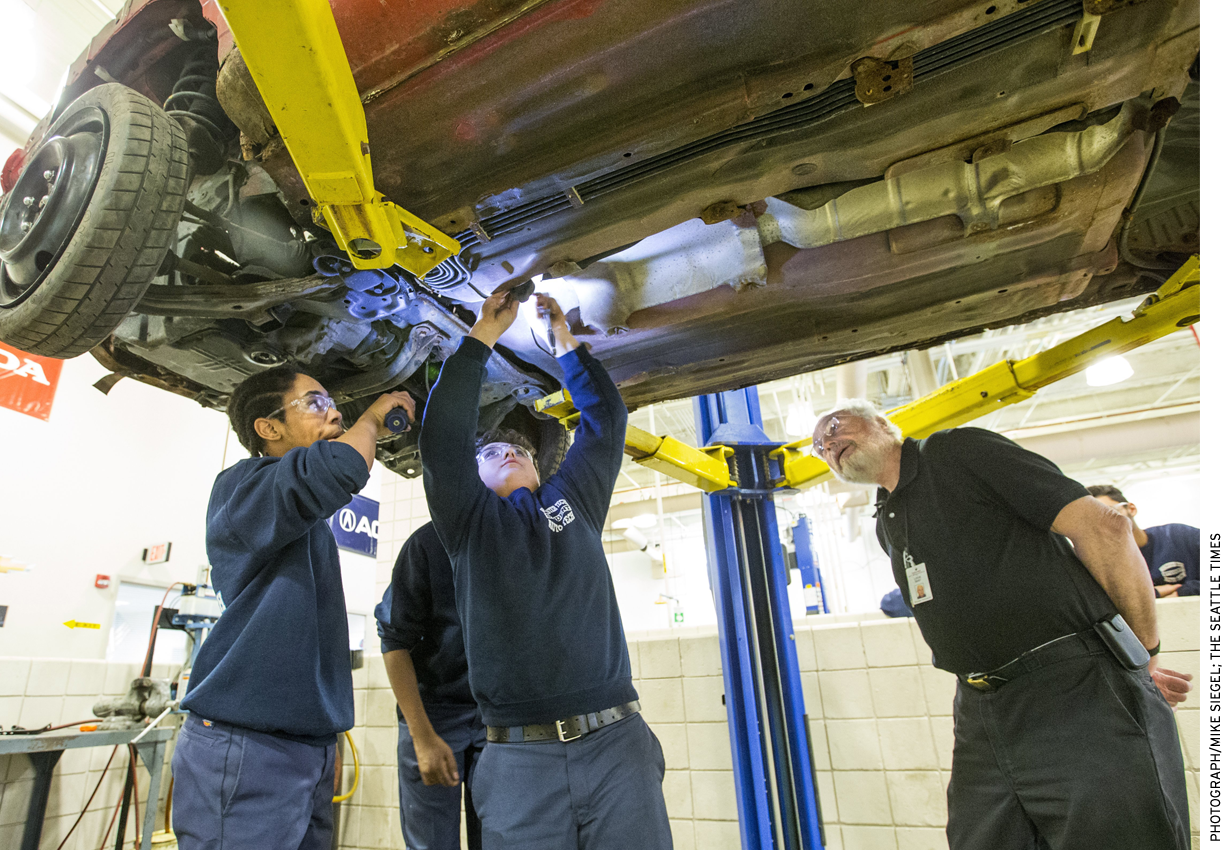
College and labor-market outcomes
What do these patterns mean for college going and labor-market performance? To understand this, we follow students through college and into the labor market, observing the relationship between vocational)course taking in high school and college enrollment, graduation, and labor-market outcomes. We limit our comparisons to students who graduated from high school in the same state and year, ensuring that any relationships that we document will not reflect differences in state graduation requirements or local labor markets. Our analysis reveals that while lower-level vocational courses may deter students who are on the fence about enrolling in college from doing so, upper-level courses are not strongly predictive of college enrollment. But we find no negative impact of lower-level courses on college graduation, and some positive impact of advanced vocational courses. And while upper-level vocational courses benefit students in the labor market, low-level vocational courses have no effect.
College enrollment and completion: On the whole, we find only weak relationships between the number of vocational courses students take and their likelihood of attending college. Students who take a larger number of low-level or advanced vocational courses have similar college-enrollment rates at both two- and four-year colleges as students who take fewer such courses.
Among students who do enroll in college, however, each additional course credit from an advanced vocational class increases their chances of graduating by nearly 2 percentage points. As expected, we also find a relationship between academic course credits and graduation among college enrollees. Each additional academic course credit is associated with an increase of 2 percentage points in graduation rates for low-level academic courses and 4 percentage points for advanced academic courses.
Taken together, these results suggest that vocational courses may deter the marginal student from college but have little aggregate impact on graduation rates among college matriculants. Put differently, vocational courses may pull those students out of college who are least likely to graduate if they enroll.
This evidence is again suggestive of a learning process in which vocational coursework provides students with information about what flavor of education best fits their talents. An alternative explanation is that the opportunity to take vocational coursework compels some students who otherwise would have dropped out to graduate from high school, but that these students are the least likely to attend college. This would result in lower college-enrollment rates and higher college-graduation rates among those who enroll, consistent with the data we see.
Wages: To examine the labor-market consequences of vocational course taking, we measure the relationship between enrollment in low-level and advanced vocational classes and students’ hourly wages, which we observe at multiple ages. As before, our analysis takes into account other student characteristics, such as parental education, family income, race, ability as measured by the armed-forces qualifying exam, and the state and year of high-school graduation. In some analyses, we also account for the composition of students’ non-vocational courses. This is a subtle yet important adjustment, which takes into consideration that an additional vocational course may come at the expense of an additional college-prep class.
We find no relationship between taking low-level vocational classes and wages after accounting for these factors (see Figure 3). But we do find that taking upper-level vocational classes has a positive impact on wages, with an increase of 2 percent for every high-level class. We obtain similar results regardless of whether we control for the number of non-vocational courses taken, which suggests that vocational courses are not crowding out more-academic classes. This is important, because we also find evidence that high-level academic courses are associated with higher earnings.
We also calculate the relationship between vocational courses and wages after controlling for whether students attended and completed college. The earnings advantage associated with core academic coursework declines by more than half after controlling for college attendance and graduation, implying that the majority of wage gains associated with core academic coursework are explained by the fact that such students are more likely to succeed in college. The courses may in fact have little direct value in the labor market. But the positive wage gains associated with upper-level vocational courses are largely unaffected by the inclusion of these factors, suggesting a premium of 1.8 percent for each additional year of upper-level vocational coursework, even conditional on whether students enroll in or graduate from college. This reveals what we view as the unique impact of advanced vocational study, above and beyond any effect on college going.
There may be other factors affecting these results, and we cannot be certain that we have identified a causal relationship. However, we take this as prima facie evidence that the labor-market value of vocational coursework accrues largely to non-college graduates, while the labor-market value of non-vocational coursework is largely if not entirely explained by its contribution to postsecondary attainment.
These results hold true in a variety of analyses, such as looking only at adults older than age 23 or only at those working more than 35 hours per week. We also find that students taking more-advanced vocational courses are less likely to be “idle,” defined as being not in work and also not in school. Hence, benefits are not simply in terms of wages. We also see that wage gains associated with advanced vocational coursework are more evident in certain industries, such as transportation, construction trades, health care, and business management.
Policy implications
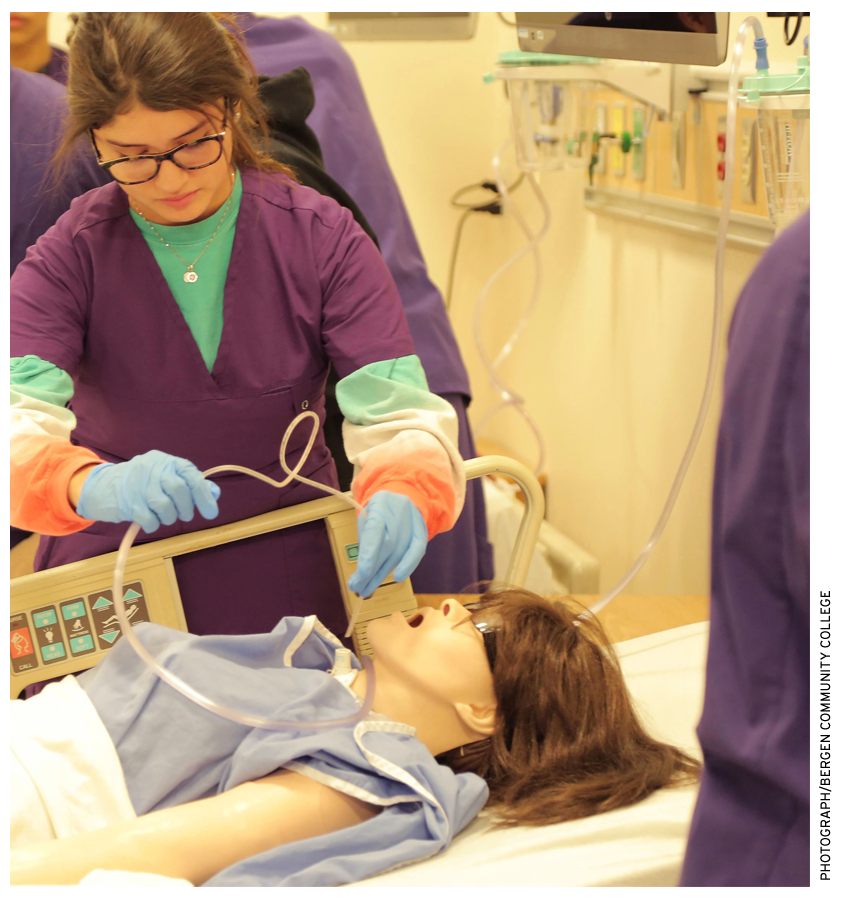
Our analysis reveals several subtle yet sharp distinctions with direct policy implications. First, we find that vocational coursework may enable students to make more informed choices about their likely fit with college. Taking more advanced vocational coursework is associated with lower four-year college-enrollment rates but no reduction in college completion, suggesting that students nudged away from four-year colleges by their exposure to a vocational secondary curriculum were unlikely to earn a degree had they enrolled. Early exposure to a vocational curriculum may thus facilitate better post-secondary enrollment decisions before students make potentially expensive mistakes—an important priority amid concerns about the number of college dropouts burdened with student debt.
Second, we demonstrate that students who complete more specialized vocational coursework earn higher wages in their early careers. We attribute this to students positively sorting into coursework that aligns with their talents and preferences, unlike the common perception that less-able students are pushed into vocational coursework. This is an important distinction, one that denotes that limiting students’ ability to take these courses, such as through more prescriptive graduation requirements, may make many of them worse-off.
Third, we show the value of depth over breadth, with the biggest wage premiums going to students who complete a series of industry-specific advanced classes. There are of course caveats to these conclusions, such as the relatively young age of our sample. Recent work by Eric A. Hanushek and Ludger Woessman, for example, suggests that overly specialized training in high school may limit workers’ ability to adapt to changing labor-market conditions later in life. The extent to which that phenomenon affects U.S. workers would be wise to address in future research.
Last, we demonstrate that while wage gains associated with core and elective academic courses are largely explained by college enrollment and graduation, wage gains from advanced vocational courses are unaffected by controlling for college enrollment and completion, suggesting that these courses have value in the labor market. This evidence speaks directly to criticisms that vocational education is “preparing students for jobs that don’t exist,” or that it is a catchall for low-ability students. Our results support neither of these conclusions.
How high schools should prepare students for life after graduation—college, the workforce, citizenship—is an enduring policy question. This is nowhere more evident than in the recent shift from “college for all” to “college and career” and in the simultaneous drive toward increased academic rigor and workforce preparedness in high-quality vocational programs that use a career pathways approach. The research presented here makes a strong case for not only keeping vocational education an accessible part of the high-school curriculum, but also for ensuring such programs provide opportunities for the sort of in-depth study that our research shows has positive effects on students’ lives after high school.
Daniel Kreisman is assistant professor of economics at Georgia State University and director of CTEx. Kevin Stange is associate professor of public policy at the University of Michigan.
This article appeared in the Fall 2019 issue of Education Next. Suggested citation format:
Kreisman, D., and Stange, K. (2019). Depth Over Breadth: The Value of Vocational Education in U.S. High Schools. Education Next, 19(4), 76-83.


